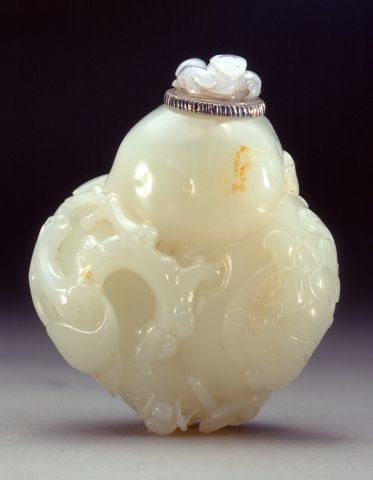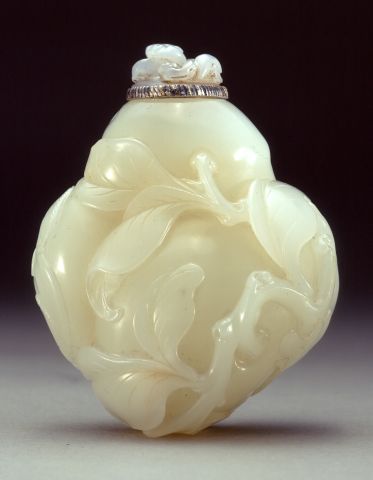

Bottle ID: 922
CARVED AS LEAFY PEACHES
Date: 1740-1800
Height: 64 mm
Nephrite, very well hollowed, of even white tone, with the russet skin showing faintly, carved in the form of three ripe peaches covered with leafy foliage, a crawling insect and a Qilong.
Imperial, attributed to the Palace Workshops, Beijing.
Similar Examples:
Crane Collection no. 291
Snuff Bottles - The Complete Collection of Treasures of the Palace Museum, Vol. 47, Beijing, 2003, p. 140, no. 205.
Moss, Hugh, Victor Graham and Ka Bo Tsang. A Treasury of Chinese Snuff Bottles - The Mary and George Bloch Collection, 1995, Vol. 1, pp. 160-163, no. 64.
Parke-Bernet Galleries Inc., New York, December 2, 1969, lot 142, Collection of Mrs. Elmer A. Claar, Part One.
Provenance:
Asian Art Studio
Beaussant Lefevre, Paris, France, November 18, 2005, lot 82
A Parisian family [ 1914-2005 ]
Monsieur Ardley, Avenue Montaigne, Paris, France, 1914
The peach is a symbol of immortality. This stems from the legend of Xi Wangmu, the Queen of the West who lived at the Jasper Pool, high in the Kunlun Mountains. In the gardens of her beautiful palace were peach trees that bore fruit once every three thousand years. The fairy peaches, once ripe, were served at the Queen's banquet, bestowing immortality on those who ate them. In the 'Journey to the West' the monkey king, Sun Wukong, was deeply insulted that he was not invited to the Queen's party, however he went to the Palace anyway and ate most of the peaches, and causing chaos in his pursuit of immortality.
< Back to full list
 English
English 中文
中文